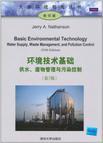环境技术基础
2011-1
纳桑森(Jerry A.Nathanson) 清华大学出版社 (2011-01出版)
纳桑森
534
在21世纪初,面临各种环境问题,人类清醒地认识到要走可持续发展之路。而发展环境教育是解决环境问题和实施可持续发展战略的根本。高等学校的环境教育,是提高新世纪建设者的环境意识,并向社会输送环境保护专门人才的重要途径。为了反映国外环境类教材的最新内容和编写风格,同时也为了提高学生阅读专业文献和获取信息的能力,我们精选了一些国外优秀的环境类教材,组成大学环境教育丛书影印版和翻译版,本书即为其中的一册。所选教材均在国外被广泛采用,多数已再版,书中不仅介绍了有关概念、原理及技术方法,给出了丰富的数据,还反映了作者不同的学术观点。我们希望这套丛书能对高等院校师生和广大科技人员有所帮助,同时为我国环境教育的发展作出贡献。
《环境技术基础:供水、废物管理与污染控制(第5版)(影印版)》为环境技术概论课程的教材。书中涉及了广泛的环境题材,重点内容为水和废水、固体和危险废物、空气和噪声污染控制。书中有较多实际案例,并配有大量例题、大量的图表和照片,各章后有复习思考题、练习题和相关网站介绍。 《环境技术基础:供水、废物管理与污染控制(第5版)(影印版)》注重基本概念和实际应用,内容精炼而丰富,易于阅读。没有先修过生物学、化学、地质学及水力学等课程的学生可理解教材的内容,适合教师在较少的学时里介绍比较广泛的内容。 《环境技术基础:供水、废物管理与污染控制(第5版)(影印版)》适合作为高等学校环境类专业、市政工程专业的教材,并供有关科技人员参考。
作者:(美国)纳桑森(Jerry A.Nathanson)
1 Basic Concepts 11.1 Overview of Environmental Technology 21.2 Public Health 61.3 Ecology91.4 Geologyand Soils 161.5 Historical Perspective 211.6 Chapter Synopsis 231.7 Relevant Web Sites 24Review Questions 252 Hydraulics 272.1 Pressure 282.2 Flow 332.3 Flow in Pipes Under Pressure 372.4 Gravity Flow in Pipes 402.S Nonuniform Open Channel Flow 472.6 Computer Applications in Hydraulics 512.7 Chapter Synopsis 522.8 Relevant Web Sites 53Review Questions 53Practice Problems 543 Hydrology 573.11 Water Use and Availability 573.2 The Hydrologic Cycle 583.3 Rainfall 603.4 Surface Water 673.5 Droughts723.6 Reservoirs743.7 Groundwater783.8 Chapter Synopsis823.9 Relevant Web Sites83Review Questions84Practice Problems854 Water Quality8943 Fundamental Concepts in Chemistry904.2 Physical Parameters of Water Quality 1014.3 Chemical Parameters of Water Quality 1024.4 Biological Parameters of Water Quality 1094,5 Water Sampling 1154.6 Chapter Synopsis 1184.7 Relevant Web Sites 119 Review Questions 120Practice Problems 1215 Water Pollution 1235.11 Classification of Water Pollutants 1245.2 Thermal Pollution 125S.3 Soil Erosion and Sediment Control 1265.4 Stream Pollution 1285.5 Lake Pollution 1325.6 Groundwater Pollution 1355.7 Ocean Pollution 1385.8 Water Quality Standards 11415.9 Clean Water Action Plan 1425.110 Chapter Synopsis 1445.11 Relevant Web Sites 145Review Questions 146Practice Problems 1476 Drinking Water Purification 1496.11 Safe Drinking Water Act 1516.2 Sedimentation 1566.3 Coagulation and Flocculation 1606.4 Filtration 1636.5 Disinfection 11676.6 Other Treatment Processes 1736.7 Chapter Synopsis 1786.8 Relevant Web Sites 179Review Questions 180Practice Problems 18117 Water Distribution Systems 1837.3 Design Factors 1847.2 Water Mains 1867.3 Centrifugal Pumps 1937.4 Distribution Storage 2027.5 Flow in Pipe Networks 2067.6 Computer Applications 2127.7 Chapter Synopsis 2157.8 Relevant Web Sites 216Review Questions 217Practice Problems 2188 Sanitary Sewer Systems 2218.1 Sanitary Sewer Design 2228.2 Sewage Lift Stations 2338.$ Sewer Construction 2368.4 Infiltration and Inflow 2418.5 Sewer Rehabilitation 2438.6 Alternative Wastewater Collection Systems 2468.7 Computer Applications and GIS 2498.8 Chapter Synopsis 2518.9 Relevant Web Sites 252Review Questions 253Practice Problems 2549 Stormwater Management 2559.1 Estimating Storm Runoff 2569.2 Storm Sewer Systems 2639.3 Best Management Practices 2679.4 Floodplains 2759.5 Control of Combined Sewer Overflow 2779.6 Computer Applications 2819.7 Chapter Synopsis 2839.8 Relevant Web Sites 284Review Questions 285Practice Problems 28510 Wastewater Treatment and Disposal 28710.1 Legislation and Standards 28810.2 Preliminary and Primary Treatment 29010.3 Secondary (Biological) Treatment 29310.4 Tertiary (Advanced) Treatment 309I0.5 On-Site (Decentralized) Wastewater Treatment and Disposal 31510.6 Sludge (Biosolids) Management 32610.7 Operation and Maintenance 33610.8 Chapter Synopsis 33810.9 Relevant Web Sites 339Review Questions 340Practice Problems 34211 Municipal Solid Waste 34311.1 Historical Background 34411.2 Solid Waste Characteristics 34511.3 Solid Waste Collection 34711.4 Solid Waste Processing 35011.5 Recycling 35911.6 Sanitarylandfills 368113 Chapter Synopsis 37611.8 Relevant Web Sites 377Review Questions 378Practice Problems 37912 Hazardous Waste Management 38112.1 Characteristics and Quantities 38.312.2 Transportation of Hazardous Waste 38612.3 Treatment, Storage, and Disposal 38812.4 Site Remediation 39612.5 Hazardous Waste Minimization 40912.6 Chapter Synopsis 41112.7 Relevant Web Sites 412Review Questions 41313 Air Pollution and Control 42513.1 Historical Background 41613.2 Atmospheric Factors 41613.3 Types, Sources, and Effects 42013.4 GlobaIAir Pollution 42613.5 IndoorAir Quality 43313.6 Air Sampling and Measurement 43713.7 Air Pollution Control 44513.8 Chapter Synopsis 45713.9 Relevant Web Sites 459Review Questions 460Practice Problems 46114 Noise Pollution and Control 46314.1 Basic Physics of Sound 46414.2 Measurement of Noise 46614.3 Effects of Noise 47214.4 Noise Mitigation 47214.5 Chapter Synopsis 47714.6 Relevant Web Sites 478Review Questions 478Practice Problems 479APPENDIXESA Environmental Impact Studies and Audits 481B Role of the Technician and the Technologist 489C Review of Basic Mathematics, Units, and Unit Conversions 493D Glossary and Abbreviations 505E Selected References, Software, and Video Resources 519F Answers to Practice Problems 521G Color Photographs 534INDEX 523
Agriculture is the most widespread source of pollutants entering streams and rivers: It is estimated to be responsible for about 70% of surface water pollution. Farming is a source of the silt, as well as nutrients, pesticides, and organic matter. (Livestock feeding operations, for example, confine thousands of animals in a small space and produce huge amounts of waste.) Municipal sewage treatment plants also continue to pollute rivers and streams by discharging bacteria, nutrients, and organic matter that deplete oxygen.Fish consumption is the most frequently impaired use in ponds, lakes, and reservoirs; aquatic life and swimming are also harmed. Nutrients and metals are the most significant pollutants in these bodies of water, followed by siltation and organic matter. Lakes are most sensitive to excessive nutrients and other pollutants, because they retain their contents for long periods of time. Nutrient pollution leads to algal blooms, low DO levels, fish kills, foul odors, and aquatic weed overgrowth, which interfere with recreational activities. Farm fertilizers and manure from animals are a major source of nutrients.In estuaries (bodies of coastal water where rivers meet the oceans), nutrients are the most widespread pollutants, followed by bacteria, toxic chemicals, and organic material. Excessive nutrients in estuaries lead to many of the same problems seen in lakes. High bacteria levels make the water unfit for swimming or harvesting shellfish, such as oysters and clams, which accumulate the bacteria. Storm runoff and industrial point sources are the primary sources of pollutants impairing estuaries, followed by municipal sewage and agriculture. TheEPA now participates in a National Estuary Program with the states to manage estuarine water quality.Loss of wetlands (see page 4) has decreased from as much as half a million acres per year between 1950 and 1970 to less than 100,000 acres per year between 1982 and 1992. Wetland losses result from commercial and residential development, agriculture, filling and draining,and road construction. Many activities degrade the remaining wetlands with pollutants such as sediment and nutrients. Although loss rates are decreasing, progress is still needed to stop the losses and increase the quality of the nation's wetlands.
《环境技术基础:供水、废物管理与污染控制(第5版)(影印版)》:大学环境教育丛书。

刚加入环境相关行业,完全没有知识背景,所以买来了解很基本的入门书,对饮用水、污水、废物管理初步讲解,浅显易懂